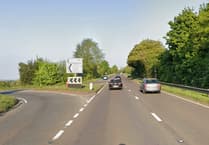John Neale is the Farnham Residents' town and borough councillor for Firgrove ward, and was leader of Farnham Town Council until April 2022 when he resigned citing a lack of support for his vision for a pedestrianised town centre. Here he shares his perspective on the current status of the project to overhaul Farnham town centre's road layout...
Readers, who are following the plot closely, will know that the town centre project in Farnham’s Infrastructure Programme (FIP), is homing in on a set of proposals for road changes in the town centre. So...
Where are we now?
Tim Oliver, leader of Surrey County Council (SCC), put out a message in December that heralded public support for ‘Option B’, the plan to widen some town centre pavements and change the traffic flow. Jeremy Hunt, our MP, followed with an encouraging message praising the progress, but, possibly for the sake of harmony, seems prepared to damp down any hope of pedestrianisation in the foreseeable future.
There remains, of course, a significant level of disquiet about various aspects of the programme, both amongst local councillors and within the wider community. Some councillors feel that as time goes on, SCC is gradually closing out on local ideas and getting on with the job back at county hall (in Reigate).
The latest Farnham Board meeting, that is meant to bring together the three councils, only had one board member in the council chamber – the member for the town council. The three-council branding had disappeared off the latest documents, and questions from the public were not answered. None of this went down well with the members of the public who attended, outnumbering the hosts.
Are Farnham people being listened to?
The biggest challenge for this project has always been the aspiration to create a pedestrian zone in the town centre. This is embedded in the ‘Vision’ document that underpins the Infrastructure Programme and many preceding initiatives over the last 30 years. It is supported by The Farnham Society, other key organisations and stakeholders in the town.
The aspiration was presented as one of three viable options in 2022, ready for public consultation. Yet, mysteriously, when the consultation was held, last summer, the pedestrianisation option was ditched. The support that Tim Oliver refers to above is for the choice between the two other options, one of which was a minor change (Hobson’s choice).
It does not ask voters whether they would still like to achieve a pedestrian zone in the foreseeable future.
How did this come about?
I believe that SCC has been persuaded, by certain vested interests, that “there is not really much support for pedestrianisation”. How does that square with the support expressed in the public polls of 2014 (52 per cent), 2019 (73 per cent), 2022 (80 per cent). Jeremy Hunt, with my support in a Farnham Board meeting, asked for a new referendum last year, to revalidate the public view in light of the technical work that had been done and the changing environment that we live in today.
I would still recommend that the public is polled again, so that we can know, with some certainty, what the democratic view is today. That would remove any doubts cast about the validity of the earlier surveys and lead to much stronger support for the project from the public, so long as its view was heeded.
Current proposals
Today’s SCC plan is for a road system much like today. The main difference is that traffic from Castle Street will be able to turn right into The Borough, hence avoiding the need to go round the one-way system if it is heading west. Parts of Downing Street, Castle Street and The Borough will be narrowed to provide more pedestrian space.
The result is less vehicle carriageway for the same volume of traffic. This is unlikely to reduce the current town centre congestion or relieve the air pollution problems.
Any calls from councillors for some pedestrianisation, including in East Street, have been rejected. This is probably because any further ceding of road space would just amplify the congestion.
There are no proposals for reviewing the road system in the Hale area, which should be complementing any proposals for the town centre. There are no proposals for bus service improvements, which could also help the town centre aspirations and would start to get people thinking about alternative ways to get around.
There are some detailed proposals on walk and cycle ways, however, cycle improvements for the town centre are sparse because the other proposals leave no new space for cyclists.
Some other proposals, such as the widely supported call for an access to the Upper Hart car park from Castle Hill, have also been dismissed by SCC. These will hamper any future creation of a pedestrian zone. Let’s be realistic: what gets done in the next few years is what Farnham will have to live with for the next generation; the last change was over 50 years ago.
Alternative vision
I think we are all aware of the pressing needs to reduce car use, where practical, for the sake of climate change, air pollution, health and fitness. The further down the age range you go, the stronger the demand becomes. This probably explains why support for pedestrianisation has grown steadily over the years. Limiting through traffic in the town centre would encourage us all to walk, cycle and take the bus more frequently.
The feedback I get from many people and local organisations is that the town will support the councils taking a proactive approach to transforming our town centre in this way.
The complementary benefits are there for the taking. A town centre where pedestrians have freedom to roam is exactly what people want today, which is why we see it happening all over the country and abroad. Farnham town council would exploit its skills at providing a better streetscene and providing more of its popular events and markets.
We would also be able to restore the town centre conservation area to what it should be, removing a lot of the paraphernalia that comes with traffic control, and smartening up the buildings for the benefit of both townsfolk and visitors. Retail, hospitality and entertainment businesses would undoubtedly prosper, as has been experienced elsewhere.
Where next?
So, come on SCC, take us on a journey with an end date of, say, 2030 (matching our climate change policies), wherein we put together, step by step, all the changes that will ultimately deliver a vibrant, community-focussed town centre.
One more benefit: at long last Farnham would be able to stop debating the future of its town centre and focus its attention and resources on more progressive initiatives for the town.





Comments
This article has no comments yet. Be the first to leave a comment.